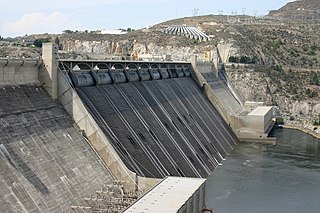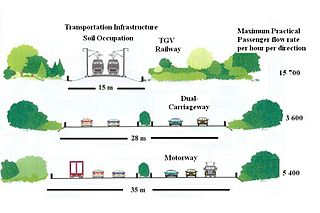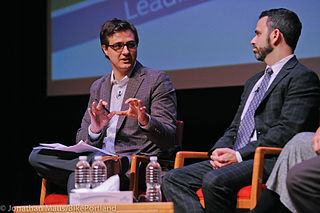
Smart growth is an urban planning and transportation theory that concentrates growth in compact walkable urban centers to avoid sprawl. It also advocates compact, transit-oriented, walkable, bicycle-friendly land use, including neighborhood schools, complete streets, and mixed-use development with a range of housing choices. The term "smart growth" is particularly used in North America. In Europe and particularly the UK, the terms "compact city", "urban densification" or "urban intensification" have often been used to describe similar concepts, which have influenced government planning policies in the UK, the Netherlands and several other European countries.

Transportation planning is the process of defining future policies, goals, investments, and spatial planning designs to prepare for future needs to move people and goods to destinations. As practiced today, it is a collaborative process that incorporates the input of many stakeholders including various government agencies, the public and private businesses. Transportation planners apply a multi-modal and/or comprehensive approach to analyzing the wide range of alternatives and impacts on the transportation system to influence beneficial outcomes.

Infrastructure is the set of facilities and systems that serve a country, city, or other area, and encompasses the services and facilities necessary for its economy, households and firms to function. Infrastructure is composed of public and private physical structures such as roads, railways, bridges, airports, public transit systems, tunnels, water supply, sewers, electrical grids, and telecommunications. In general, infrastructure has been defined as "the physical components of interrelated systems providing commodities and services essential to enable, sustain, or enhance societal living conditions" and maintain the surrounding environment.

Land use planning or Land-use regulation is the process of regulating the use of land by a central authority. Usually, this is done to promote more desirable social and environmental outcomes as well as a more efficient use of resources. More specifically, the goals of modern land use planning often include environmental conservation, restraint of urban sprawl, minimization of transport costs, prevention of land use conflicts, and a reduction in exposure to pollutants. In the pursuit of these goals, planners assume that regulating the use of land will change the patterns of human behavior, and that these changes are beneficial. The first assumption, that regulating land use changes the patterns of human behavior is widely accepted. However, the second assumption – that these changes are beneficial – is contested, and depends on the location and regulations being discussed.
A best practice is a method or technique that has been generally accepted as superior to alternatives because it tends to produce superior results. Best practices are used to achieve quality as an alternative to mandatory standards. Best practices can be based on self-assessment or benchmarking. Best practice is a feature of accredited management standards such as ISO 9000 and ISO 14001.

The Federal Transit Administration (FTA) is an agency within the United States Department of Transportation (DOT) that provides financial and technical assistance to local public transportation systems. The FTA is one of ten modal administrations within the DOT. Headed by an Administrator who is appointed by the President of the United States, the FTA functions through Washington, D.C. headquarters office and ten regional offices which assist transit agencies in all states, the District of Columbia, and the territories. Until 1991, it was known as the Urban Mass Transportation Administration (UMTA).

Sustainable urban infrastructure expands on the concept of urban infrastructure by adding the sustainability element with the expectation of improved and more resilient urban development. In the construction and physical and organizational structures that enable cities to function, sustainability also aims to meet the needs of the present generation without compromising the capabilities of the future generations.
The Research and Innovative Technology Administration (RITA) is a unit of the United States Department of Transportation (USDOT). It was created in 2005 to advance transportation science, technology, and analysis, as well as improve the coordination of transportation research within the department and throughout the transportation community.
Social return on investment (SROI) is a principles-based method for measuring extra-financial value not otherwise reflected or involved in conventional financial accounts. The method can be used by any entity to evaluate impact on stakeholders, identify ways to improve performance, and enhance the performance of investments.
A federal enterprise architecture framework (FEAF) is the U.S. reference enterprise architecture of a federal government. It provides a common approach for the integration of strategic, business and technology management as part of organization design and performance improvement.
The term "sustainable communities" has various definitions, but in essence refers to communities planned, built, or modified to promote sustainable living. Sustainable communities tend to focus on environmental and economic sustainability, urban infrastructure, social equity, and municipal government. The term is sometimes used synonymously with "green cities," "eco-communities," "livable cities" and "sustainable cities."

A sustainable city, eco-city, or green city is a city designed with consideration for the social, economic, and environmental impact, as well as a resilient habitat for existing populations. This is done in a way that does not compromise the ability of future generations to experience the same. The UN Sustainable Development Goal 11 defines sustainable cities as those that are dedicated to achieving green sustainability, social sustainability and economic sustainability. In accordance with the UN Sustainable Development Goal 11, a sustainable city is defined as one that is dedicated to achieving green, social, and economic sustainability. They are committed to this objective by facilitating opportunities for all through a design that prioritizes inclusivity as well as maintaining a sustainable economic growth. Furthermore, the objective is to minimize the inputs of energy, water, and food, and to drastically reduce waste, as well as the outputs of heat, air pollution. Richard Register, a visual artist, first coined the term ecocity in his 1987 book Ecocity Berkeley: Building Cities for a Healthy Future, where he offers innovative city planning solutions that would work anywhere. Other leading figures who envisioned sustainable cities are architect Paul F Downton, who later founded the company Ecopolis Pty Ltd, as well as authors Timothy Beatley and Steffen Lehmann, who have written extensively on the subject. The field of industrial ecology is sometimes used in planning these cities.

Complete streets is a transportation policy and design approach that requires streets to be planned, designed, operated and maintained to enable safe, convenient and comfortable travel and access for users of all ages and abilities regardless of their mode of transportation. Complete Streets allow for safe travel by those walking, cycling, driving automobiles, riding public transportation, or delivering goods.
Context-sensitive solutions (CSS) is a theoretical and practical approach to transportation decision-making and design that takes into consideration the communities and lands through which streets, roads, and highways pass. The term is closely related to but distinguishable from context-sensitive design in that it asserts that all decisions in transportation planning, project development, operations, and maintenance should be responsive to the context in which these activities occur, not simply the design process. CSS seeks to balance the need to move vehicles efficiently and safely with other desirable outcomes, including historic preservation, environmental sustainability, and the creation of vital public spaces. In transit projects, CSS generally refers to context sensitive planning, design, and development around transit stations, also known as transit-oriented development.
The H-GAC 2035 Regional Transportation Plan is the long range transportation plan for the Houston-Galveston Area and serves as blueprint for further planning to be undertaken in the region over the next 30 years. The plan which was developed in a joint cooperation with Cities, Counties, Texas Department of Transportation (TxDOT) and METRO. The RTP combines research, plans and programs by various organizations into one comprehensive plan which is updated every four years. The RTP's main aim is to identify long-range transportation needs, prioritize programs and projects and to provide a forum for dialogue and regional problem solving.

The Transportation Expansion (T-REX) Project was a $1.67 billion project aimed at improving transportation options for commuters in the Denver metro area within the areas of Interstate 25 and 225, which was recognized as the 14th busiest intersection in the United States at the time. The T-REX effort widened major interstates to up to 5 mainline lanes in each direction and added 19 miles (31 km) of double-track light rail throughout the metropolitan area. The T-REX project finished 3.2% under its $1.67 billion budget and 22 months ahead of schedule in 2006.

Gabe Klein is a government official, urban planner, entrepreneur, and an investor specializing in sustainability and transportation.
Construction partnering is a type of business partnering used in the architecture, engineering and construction industry. Partnering is intended to assist project teams with setting goals, resolving disputes and improving project outcomes. The construction partnering team is made up of the project’s owner (client), the consulting engineers and/or architects, the contractor(s) and other key project stakeholders. Construction partnering has been used both in the United States and elsewhere since the early 1980s as a methodology to reduce litigation and improve productivity.
Sidewalk Labs LLC was an urban planning and infrastructure subsidiary of Google. Its stated goal was to improve urban infrastructure through technological solutions, and tackle issues such as cost of living, efficient transportation and energy usage. The company was headed by Daniel L. Doctoroff, former Deputy Mayor of New York City for economic development and former chief executive of Bloomberg L.P. until 2021. Other notable employees include Craig Nevill-Manning, co-founder of Google's New York office and inventor of Froogle, and Rohit Aggarwala, who served as chief policy officer of the company and is now Commissioner of New York City Department of Environmental Protection. It was originally part of Alphabet Inc., Google's parent company, before being absorbed into Google in 2022 following Doctoroff's departure from the company.

The study of Engineering Economics in Civil Engineering, also known generally as engineering economics, or alternatively engineering economy, is a subset of economics, more specifically, microeconomics. It is defined as a "guide for the economic selection among technically feasible alternatives for the purpose of a rational allocation of scarce resources." Its goal is to guide entities, private or public, that are confronted with the fundamental problem of economics.










